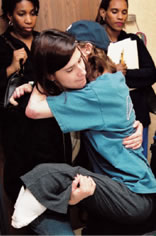| |

Information on meningitis

An
Ordinary Life
Education
Crisis
Songs
of the Shaman
Sam
Moon Madness
|
|
|
What’s
so special about leading a normal college life?
Ask
Lydia M. Evans, a sophomore from Fort Worth.
Not many students would make trying to live a normal life a priority,
but Evans is moving a step closer to normalcy every day and loving
it.
Now, as she did at the beginning of the Fall 2001 semester, she
has a boyfriend, a roommate, a schedule of classes and a social
life.
The difference this year is that she has come back from a 4 percent
chance of survival and her steps are on $40,000 artificial legs.
Critical
condition

|
 |
 |
In March, Evans was still in the hospital, learning how to return
to an active life.
|
 |
 |
On
Sept. 23, 2001, Evans was diagnosed with the most infectious strain
of bacterial meningitis (meningococcal). She was in critical condition
— in a coma for two weeks and awake but paralyzed from the
neck down for many more.
On Sept. 22, she started feeling sick at a party and went home.
There, she called her mother, Elizabeth de Evans, and asked for
soup.
Sometime after 1 a.m., when purple spots began breaking out on her
body, Evans went to Presbyterian Hospital in Dallas, where she tested
positive for meningitis. She fell into a coma the next day.
Bacterial meningitis strikes swiftly and unexpectedly. The germ
causes a blood-poisoning reaction that leads to organ failure and
allows gangrene to develop. The disease begins with flu-like symptoms,
but it can be fatal within 24 hours.
During her coma, Evans’ lungs collapsed, her liver failed
and her body became covered with open wounds where tissue had died
from the blood poisoning.
“There were numerous times the doctors and nurses would take
us into Lydia’s room and tell us to say goodbye,” says
Evans’ roommate, Sundey Stewart, a junior from The Colony.
Doctors
performed I.Q. tests on Evans after she woke up to make sure she
had not suffered brain damage, a common effect of bacterial meningitis.
The results showed she suffered no mental impairment.
 |
 |
 |
| |
 |
 Lisa
Hines visited with Evans and helped her do the things she couldn’t. Lisa
Hines visited with Evans and helped her do the things she couldn’t. |
Because
so much tissue had died, doctors were forced to amputate Evans’
legs below the knees, both of her thumbs and portions of seven of
her fingers. Subsequently, the medical teams reconstructed her thumbs
using muscle and arteries from other parts of her body.
She was
continuously hospitalized for both medical treatment and rehabilitation
until the end of March.
“People don’t really notice [my legs] anymore if I’ve
got pants on because I’m walking so well,” Evans says.
So far, she has undergone 18 surgeries and has at least one major
reconstructive surgery scheduled for next summer. After that, her
doctors cannot estimate how many cosmetic surgeries she may need.
Back
to school
Evans returned
to her UNT classes in the fall. She is once again active in her
sorority, Pi Beta Phi, and has resumed her involvement in other
campus activities.
Evans plans to stick to her original goal and hopes to graduate
from UNT with a degree in international studies in May 2004.

|
 |
 |
Evans returned to UNT this fall.
|
 |
 |
She insists
that her illness did not change her dramatically.
“If
anything, I guess I’m more forgiving now because I realized
how quickly it can all be taken away,” she says. “I
think my friends are more affected by this than I was. I didn’t
see how sick I was. I never thought I was going to die. When I woke
up, it was like, ‘What’s the big deal?’”
She says she wants to return as much as she can to the way she lived
before contracting meningitis. And she’d prefer not to be
credited for her remarkable turnaround in the face of death.
“It really bothers me when people say I’m an inspiration,”
Evans says. “Living or surviving something doesn’t make
me great. … I don’t want to be somebody’s hero.
I’m the same person I was before, and I don’t want to
let anybody down."
|
note
Health
officials never determined where Lydia Evans contracted meningitis.
However, when the disease was identified, warnings were circulated
throughout the university community for people who may have
had contact with her when she was contagious to go to the
Health Clinic for a free, one-time antibiotic treatment. Thousands
of students responded. Many other students took advantage
of two special vaccination sessions on campus during the Fall
2001 semester. There were no other cases.
The UNT Student Health and Wellness Center offers meningitis
vaccinations year round and also holds special vaccination
clinics in the fall semester for students, faculty, staff
and community members. The university mails information about
meningitis vaccinations to the parents of students 25 and
younger after the 12th class day each fall. New UNT students
also receive information about meningitis during registration.
Each year in the United States, there are about 3,000 meningococcal
disease cases, including 300 deaths. Of these cases, about
125 to 175 occur among college students, including 15 to 20
deaths.
|
About
the writer and photographer: Students Ava N. Benson, senior,
and Amy Wiseman, junior, are journalism majors.
|
|




